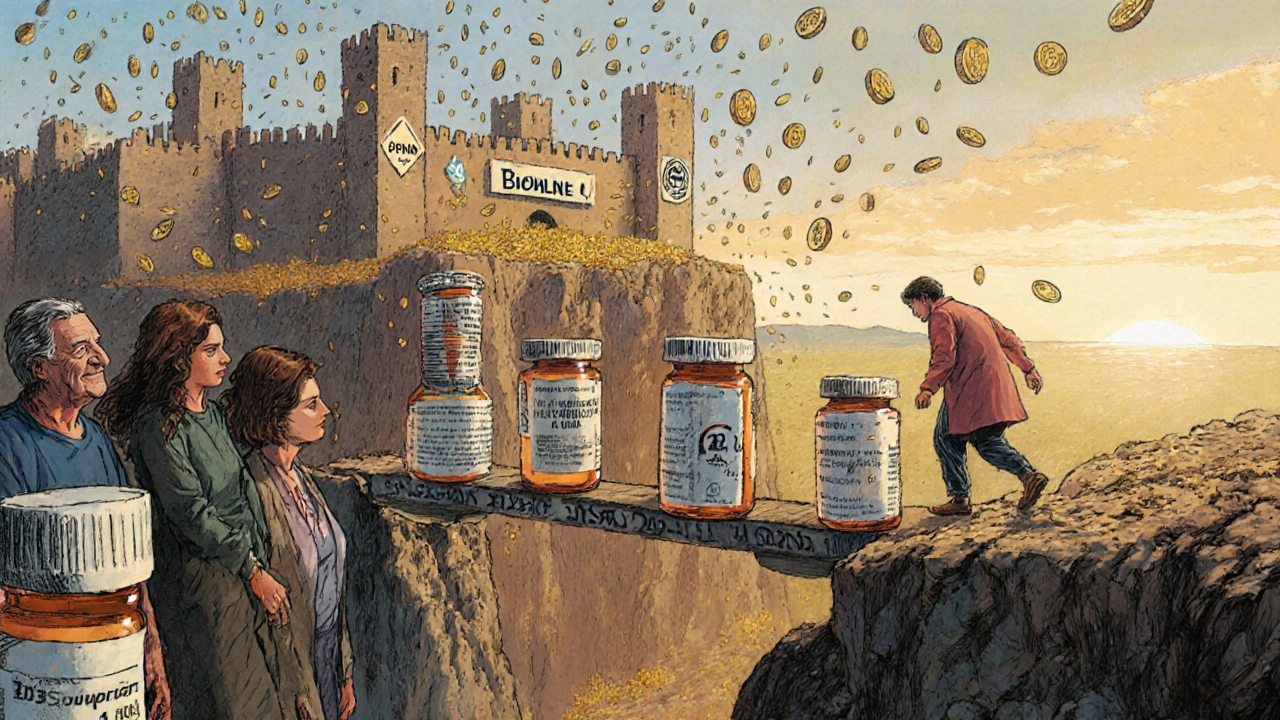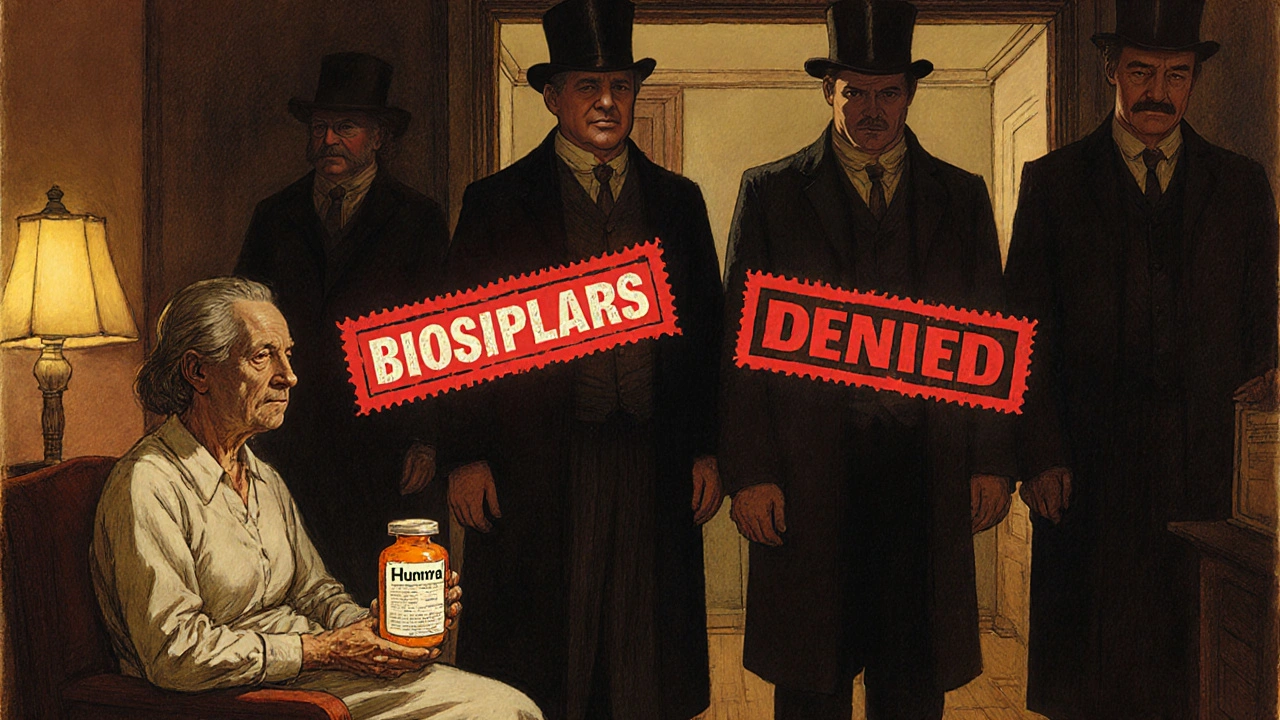25 Nov 2025
- 15 Comments
When you’re prescribed a biologic drug like Humira for rheumatoid arthritis or Crohn’s disease, the cost can be staggering-often over $4,000 a month. Biosimilars, which are nearly identical copies of these expensive drugs, were supposed to change that. They’re FDA-approved, clinically proven, and cost 10-33% less. But if your insurance won’t cover them-or makes it harder to get them than the original drug-then the savings don’t matter. In 2025, biosimilars are still fighting an uphill battle not because of science, but because of how insurance plans are structured.
Why Biosimilars Are Different From Generics
You’ve probably heard of generic drugs. They’re cheap copies of pills like metformin or lisinopril. Biosimilars aren’t like that. They’re made from living cells-not chemicals-and even tiny differences in how they’re grown can affect how they work. That’s why the FDA requires much more testing for biosimilars than for regular generics. But once approved, they’re just as safe and effective. The problem? Insurance companies treat them like they’re risky, even though they’re not.Take adalimumab-the active ingredient in Humira. By 2025, there were eight FDA-approved biosimilars for it. Yet only half of Medicare Part D plans covered any of them. And when they did, they often put them on the same tier as Humira. That means you pay the same out-of-pocket cost whether you get the original or the cheaper version. If Humira costs $5,000 a month and your biosimilar costs $4,200, your copay might still be $1,200. Where’s the incentive to switch?
Prior Authorization: The Hidden Gatekeeper
Nearly every insurance plan that covers biologics requires prior authorization. That’s when your doctor has to jump through hoops to prove you need the drug. For Humira, that usually means showing you tried and failed other treatments first. But here’s the twist: the same requirement applies to biosimilars. And in 98.5% of cases, the rules are just as strict-even though biosimilars are proven to work just as well.Doctors report spending 3 to 5 hours a week just filling out these forms. One rheumatologist in Ohio told me she had a patient wait 28 days for treatment because her plan forced her to try a biosimilar first-even though the patient had already tried two other biologics without success. That’s not clinical judgment. That’s bureaucracy.
Prior authorization isn’t just slow. It’s inconsistent. One insurer might require a letter from your doctor. Another might demand lab results from six months ago. And if you’re on Medicare Part D, your plan changes every year. What was covered in January might be denied in July.
Tier Placement: The Cost Trap
Insurance plans use tiers to control costs. Tier 1 is your cheapest generic pills. Tier 4 or 5? That’s where biologics live. Most plans put Humira on Tier 5. And guess what? Most biosimilars are on Tier 5 too. Only 1.5% of plans put biosimilars on a lower tier to encourage use. That’s not a mistake. It’s by design.Here’s how it works: if you’re on a Tier 5 drug, you pay 33% of the cost. For a $5,000 drug, that’s $1,650 a month. If your biosimilar costs $4,200, your share drops to $1,386. You save $264 a month. But you still pay over $1,300. That’s not a savings-it’s a burden. And for many patients, especially those on fixed incomes, that’s not worth the hassle of switching.
Even worse, some plans don’t cover biosimilars at all. In 2025, UnitedHealthcare, CVS, and Cigna still didn’t list any insulin biosimilars on their formularies-even though eight adalimumab biosimilars were available. That’s not about safety. It’s about contracts. Drugmakers pay PBMs (pharmacy benefit managers) big money to keep their brand drugs on top. And those PBMs don’t want to lose that income.

How PBMs Are Changing the Game
But something’s shifting. In 2025, Express Scripts, OptumRx, and CVS Caremark started excluding Humira from their national formularies entirely. That means if you want Humira, you can’t get it unless your doctor gets special approval. But if you want a biosimilar? It’s on a preferred tier-Tier 3-with lower coinsurance and fewer hoops to jump through.This is a big deal. It’s no longer about encouraging biosimilars. It’s about forcing them. PBMs are using exclusion as a tool. If you can’t get the original drug, you have to take the cheaper version. It’s blunt, but it works. Early data shows that when Humira is removed from formularies, biosimilar use jumps by 40% in six months.
This strategy is spreading. The Congressional Budget Office estimates that if this trend continues, biosimilars could save the U.S. healthcare system $54 billion over the next decade. Right now, we’re on track to save only $1.8 billion a year because of the way coverage is set up. The difference? One is about patient choice. The other is about forcing the right decision.
What Patients Are Really Paying
Let’s say you’re on Medicare Part D. You’ve been on Humira for two years. Your monthly cost is $1,200. Your doctor suggests switching to a biosimilar. You check your plan’s formulary. The biosimilar is on the same tier. Your copay? $1,150. You save $50 a month. But now you have to go through prior authorization again. You have to refill your prescription through a specialty pharmacy. You have to call your doctor’s office every time your insurance changes its mind.That $50 isn’t worth the stress. Especially when you’re already tired from managing a chronic illness. A survey by the Medicare Rights Center found that 62% of patients didn’t switch to biosimilars-not because they didn’t want to, but because the process was too complicated.
And it’s not just money. It’s time. One patient in Texas waited 11 weeks to get her biosimilar approved after her Humira was discontinued. She missed two months of treatment. Her arthritis flared. She ended up in the ER. That’s the hidden cost of bad coverage.

What’s Changing in 2025
The government is paying attention. In late 2024, the Office of Inspector General found that most Medicare plans still didn’t give biosimilars a better shot. In response, CMS started requiring plans to report how they place biosimilars on tiers. And in 2025, new rules under the Inflation Reduction Act are pushing PBMs to stop treating biosimilars like second-class drugs.Some insurers are already ahead of the curve. A few Medicare Advantage plans now offer $0 copays for biosimilars if you’ve tried and failed the reference drug. Others have dropped prior authorization entirely for biosimilars. These are small wins-but they’re growing.
The real turning point? When biosimilars start appearing on Tier 2 instead of Tier 5. That’s when patients will actually choose them-not because they’re forced to, but because it makes sense.
What You Can Do
If you’re on a biologic and your doctor suggests a biosimilar, don’t assume it’s the same as switching from brand-name to generic. Ask these questions:- Is the biosimilar on the same tier as the original drug? If yes, ask why it’s not on a lower tier.
- Do I need prior authorization for the biosimilar? If so, can my doctor skip it since it’s proven equivalent?
- What’s my out-of-pocket cost difference between the two? If it’s less than $100 a month, is the switch worth the hassle?
- Does my plan exclude the original drug? If yes, I might be forced into the biosimilar anyway-so ask about support programs.
Also, talk to your pharmacist. Specialty pharmacies often have patient assistance programs that can cut your costs by half-even if your insurance doesn’t budge.
And if you’re frustrated? Speak up. Call your insurer. Ask why biosimilars aren’t treated like the safe, effective alternatives they are. Patient pressure has already forced changes in insulin coverage. It can do the same for biosimilars.
What’s Next
By 2027, experts predict biosimilars will make up 40% of the biologics market-up from 23% today. But that only happens if coverage rules change. Right now, insurance is the biggest barrier-not science, not safety, not cost. It’s policy.The goal was simple: make life-saving drugs affordable. Biosimilars were supposed to be the answer. But if insurers keep treating them like an afterthought, we’ll keep paying the same prices-and patients will keep waiting.
Are biosimilars as safe as the original biologic drugs?
Yes. Biosimilars undergo rigorous testing by the FDA to prove they’re highly similar to the reference biologic in terms of safety, purity, and potency. They’re not generic copies-they’re complex biological products made from living cells-but they’ve been shown in clinical trials to work the same way with no meaningful differences in side effects or effectiveness.
Why don’t insurance plans put biosimilars on lower tiers?
Many plans don’t because pharmacy benefit managers (PBMs) receive rebates from the makers of original biologics. Putting biosimilars on lower tiers reduces those rebates. Even though biosimilars cost less, PBMs often make more money by keeping the original drug on preferred tiers. Some insurers are changing this-especially as government pressure grows-but it’s still common.
Can pharmacists substitute a biosimilar for the original drug without asking my doctor?
Only if the biosimilar has been designated as “interchangeable” by the FDA. As of 2025, only a few biosimilars have that status-and even then, only for specific formulations. Most biosimilars still require a new prescription from your doctor, even if they’re clinically identical. That’s one reason adoption is slow.
What’s the difference between a biosimilar and a generic drug?
Generics are exact chemical copies of small-molecule drugs like aspirin or metformin. Biosimilars are made from living cells and are “similar but not identical” to their reference biologic. They require far more testing to prove they work the same way. You can’t swap a biosimilar for a biologic the way you can swap generic ibuprofen for brand-name Advil.
How can I find out if my insurance covers a specific biosimilar?
Check your plan’s formulary online-most insurers list it under “Drug List” or “Formulary Search.” Enter the name of the biosimilar (like Cyltezo or Hyrimoz) and see which tier it’s on. If it’s not listed, call your insurer directly. Ask if they cover any biosimilars for your condition and whether prior authorization is required. Your doctor’s office can also help you look this up.
What should I do if my insurance denies coverage for a biosimilar?
First, ask your doctor to file an appeal. Most denials can be overturned with a letter of medical necessity. If that fails, check if the manufacturer offers a patient assistance program-many do. You can also contact your state’s insurance commissioner or advocacy groups like the Alliance for Patient Access. In some cases, switching plans during open enrollment (October-December) may be your best option.


Jesús Vásquez pino
November 27, 2025My cousin’s on Humira and they made her switch to a biosimilar last year. She cried for three days thinking she’d lose her stability. Turns out? She’s doing better. Less joint pain, no new flares. The only difference? Her copay dropped from $1,400 to $900. But the paperwork? Still a nightmare. Why does saving money have to feel like a punishment?
hannah mitchell
November 28, 2025I just read this and felt my chest tighten. My mom’s on a biologic for lupus. She’s 72. The idea of her spending hours on hold with insurance while her body deteriorates… it’s not healthcare. It’s hostage negotiation.
stephen riyo
November 30, 2025Okay, so… let me get this straight: the FDA says biosimilars are just as safe, doctors say they work fine, patients say they’re better off… but insurance won’t cover them unless you jump through 17 hoops? And the reason? Rebates? Like… are we still in 2005? This isn’t a market failure-it’s a moral failure.
Jaspreet Kaur
December 1, 2025Life is not a spreadsheet. People are not line items. Biosimilars are not a cost-cutting trick-they are a bridge to dignity. When a person with chronic illness has to choose between their health and their rent, we have already lost. The system doesn’t need reform. It needs a heart.
Gina Banh
December 2, 2025Here’s the truth: PBMs are middlemen who profit from confusion. They don’t care if you live or die-they care if the rebate check clears. Biosimilars aren’t being blocked because they’re unsafe. They’re blocked because they’re too honest. No shady deals. No kickbacks. Just science and savings. And that’s why they’re being punished.
Bethany Buckley
December 3, 2025It’s fascinating how the neoliberal apparatus of pharmaceutical distribution has weaponized bureaucratic inertia to preserve rent-seeking behaviors under the guise of ‘risk mitigation.’ The cognitive dissonance between clinical equivalence and reimbursement disparity is not merely ironic-it is epistemologically violent. 🤔💸
Stephanie Deschenes
December 5, 2025If you’re a patient reading this: don’t give up. Call your insurer. Ask for the formulary exception process. Tell them you’re willing to try the biosimilar. Most of the time, they’ll approve it if you push. And if they say no? Ask for the name of the PBM. Then call them. They hate hearing from patients. That’s your leverage.
Cynthia Boen
December 6, 2025Why are we even talking about this? Just let people pay for Humira if they want it. The market works. If biosimilars are so great, why do patients need to be forced? Maybe they don’t want to switch. Maybe they’re happy. Let people choose.
Amanda Meyer
December 8, 2025While I acknowledge the systemic inequities outlined here, I must also note that the transition from branded biologics to biosimilars requires robust pharmacovigilance and clinician education. The current infrastructure is not adequately resourced to support seamless substitution. Policy must be paired with investment in provider training and patient support networks.
Albert Guasch
December 9, 2025As a healthcare administrator, I can confirm that the exclusion of Humira from formularies and the preferential tiering of biosimilars is not a punitive measure-it is a cost-containment strategy aligned with federal guidelines under the Inflation Reduction Act. The savings are real. The patient outcomes are equivalent. The resistance is emotional, not clinical.
Ginger Henderson
December 10, 2025Wow, so now we’re supposed to feel bad because insurance companies are finally doing their job? Biosimilars are cheaper? Cool. So why don’t you just take the $50 a month savings and buy a new phone? Maybe you’d feel better.
vikas kumar
December 10, 2025My brother in Delhi is on a biosimilar for psoriasis. He pays $15 a month. No prior auth. No specialty pharmacy. Just walk in, get it, go home. We have a broken system in the US. Not because science is hard. But because profit is louder than people.
Bea Rose
December 11, 2025Everyone’s acting like biosimilars are a miracle. They’re not. They’re just slightly cheaper versions of drugs that cost too much in the first place. The real problem? Biologics are overpriced. Fix that. Don’t punish patients with switching logistics.
Michael Collier
December 12, 2025It is imperative that stakeholders across the healthcare continuum-payers, providers, and patients-collaborate to align reimbursement structures with evidence-based clinical outcomes. The current tiering paradigm is misaligned with therapeutic equivalence and undermines the principle of patient-centered care.
Shannon Amos
December 13, 2025So let me get this straight… the system is so broken that the only way to get patients on cheaper meds is to *take away* the expensive ones? That’s not healthcare. That’s a hostage situation with a pharmacy receipt.